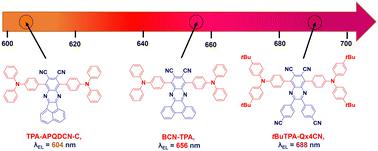当前位置:
X-MOL 学术
›
J. Mater. Chem. C
›
论文详情
Our official English website, www.x-mol.net, welcomes your
feedback! (Note: you will need to create a separate account there.)
Highly efficient deep-red to near-infrared thermally activated delayed fluorescence organic light-emitting diodes using a 2,3-bis(4-cyanophenyl)quinoxaline-6,7-dicarbonitrile acceptor
Journal of Materials Chemistry C ( IF 5.7 ) Pub Date : 2024-07-17 , DOI: 10.1039/d4tc01834f Shantaram Kothavale 1 , Kiun Cheong 1 , Seung Chan Kim 1 , Seong-Jun Yoon 2 , Jun Yeob Lee 1, 3
Journal of Materials Chemistry C ( IF 5.7 ) Pub Date : 2024-07-17 , DOI: 10.1039/d4tc01834f Shantaram Kothavale 1 , Kiun Cheong 1 , Seung Chan Kim 1 , Seong-Jun Yoon 2 , Jun Yeob Lee 1, 3
Affiliation

|
The demand for deep-red (DR) or near-infrared (NIR) emitters has grown markedly owing to their essential roles in optical telecommunications, night vision technologies, flat panel displays, bioimaging, photodynamic therapy, and sensors, among other applications. However, achieving highly efficient DR/NIR organic light-emitting diodes (OLEDs) is challenging, primarily due to the inherent limitations of the energy gap law. In this study, we propose a novel molecular design for a thermally activated delayed fluorescence emitter, tBuTPA-Qx4CN, based on the 2,3-bis(4-cyanophenyl)quinoxaline-6,7-dicarbonitrile (Qx4CN) acceptor, shifting the emission wavelength toward the DR/NIR region. The tBuTPA-Qx4CN design involves a para-directed connection between the donor moieties and the Qx4CN acceptor unit. Unlike conventional peripheral attachment of donors, two identical 4-(tert-butyl)-N-(4-(tert-butyl)phenyl)-N-phenylaniline donor units were attached at the 5,8-position of the central Qx4CN unit. Using the advantageous H-bonding effect between the donor and acceptor units, the tBuTPA-Qx4CN emitter achieved a high oscillator strength, resulting in a substantial radiative rate. The strong Qx4CN acceptor unit facilitated a marked red shift in the emission wavelength of tBuTPA-Qx4CN toward the NIR region. OLEDs incorporating tBuTPA-Qx4CN as the TADF emitter achieved enhanced external quantum efficiency of up to 16.3%, peaking at 674 nm. A new synthetic route, starting from 4,5-diamino-3,6-dibromophthalonitrile, was developed for tBuTPA-Qx4CN synthesis. This route may be useful for future designs of highly efficient DR/NIR TADF emitters for OLED applications.
中文翻译:

使用2,3-双(4-氰基苯基)喹喔啉-6,7-二甲腈受体的高效深红至近红外热激活延迟荧光有机发光二极管
由于深红 (DR) 或近红外 (NIR) 发射器在光通信、夜视技术、平板显示器、生物成像、光动力治疗和传感器等应用中发挥着重要作用,对深红 (DR) 或近红外 (NIR) 发射器的需求显着增长。然而,实现高效 DR/NIR 有机发光二极管 (OLED) 具有挑战性,这主要是由于能隙定律的固有限制。在这项研究中,我们提出了一种基于 2,3-双(4-氰基苯基)喹喔啉-6,7-二甲腈 (Qx4CN) 受体的热激活延迟荧光发射器t BuTPA-Qx4CN 的新颖分子设计,改变了发射波长朝向 DR/NIR 区域。 t BuTPA-Qx4CN设计涉及供体部分和Qx4CN 受体单元之间的对位连接。与供体的常规外周连接不同,两个相同的4-(叔丁基) -N- (4-(叔丁基)苯基) -N-苯基苯胺供体单元连接在中心Qx4CN单元的5,8-位上。利用供体和受体单元之间有利的氢键效应, t BuTPA-Qx4CN发射体实现了高振荡器强度,从而产生了相当大的辐射率。强的 Qx4CN 受体单元促进t BuTPA-Qx4CN的发射波长向近红外区域发生明显的红移。采用t BuTPA-Qx4CN作为 TADF 发射器的 OLED 实现了高达 16.3% 的增强外量子效率,峰值波长为 674 nm。 开发了一条以4,5-二氨基-3,6-二溴邻苯二甲腈为原料合成tBuTPA -Qx4CN的新合成路线。该路线可能对未来用于 OLED 应用的高效 DR/NIR TADF 发射器设计有用。
更新日期:2024-07-17
中文翻译:

使用2,3-双(4-氰基苯基)喹喔啉-6,7-二甲腈受体的高效深红至近红外热激活延迟荧光有机发光二极管
由于深红 (DR) 或近红外 (NIR) 发射器在光通信、夜视技术、平板显示器、生物成像、光动力治疗和传感器等应用中发挥着重要作用,对深红 (DR) 或近红外 (NIR) 发射器的需求显着增长。然而,实现高效 DR/NIR 有机发光二极管 (OLED) 具有挑战性,这主要是由于能隙定律的固有限制。在这项研究中,我们提出了一种基于 2,3-双(4-氰基苯基)喹喔啉-6,7-二甲腈 (Qx4CN) 受体的热激活延迟荧光发射器t BuTPA-Qx4CN 的新颖分子设计,改变了发射波长朝向 DR/NIR 区域。 t BuTPA-Qx4CN设计涉及供体部分和Qx4CN 受体单元之间的对位连接。与供体的常规外周连接不同,两个相同的4-(叔丁基) -N- (4-(叔丁基)苯基) -N-苯基苯胺供体单元连接在中心Qx4CN单元的5,8-位上。利用供体和受体单元之间有利的氢键效应, t BuTPA-Qx4CN发射体实现了高振荡器强度,从而产生了相当大的辐射率。强的 Qx4CN 受体单元促进t BuTPA-Qx4CN的发射波长向近红外区域发生明显的红移。采用t BuTPA-Qx4CN作为 TADF 发射器的 OLED 实现了高达 16.3% 的增强外量子效率,峰值波长为 674 nm。 开发了一条以4,5-二氨基-3,6-二溴邻苯二甲腈为原料合成tBuTPA -Qx4CN的新合成路线。该路线可能对未来用于 OLED 应用的高效 DR/NIR TADF 发射器设计有用。


















































 京公网安备 11010802027423号
京公网安备 11010802027423号